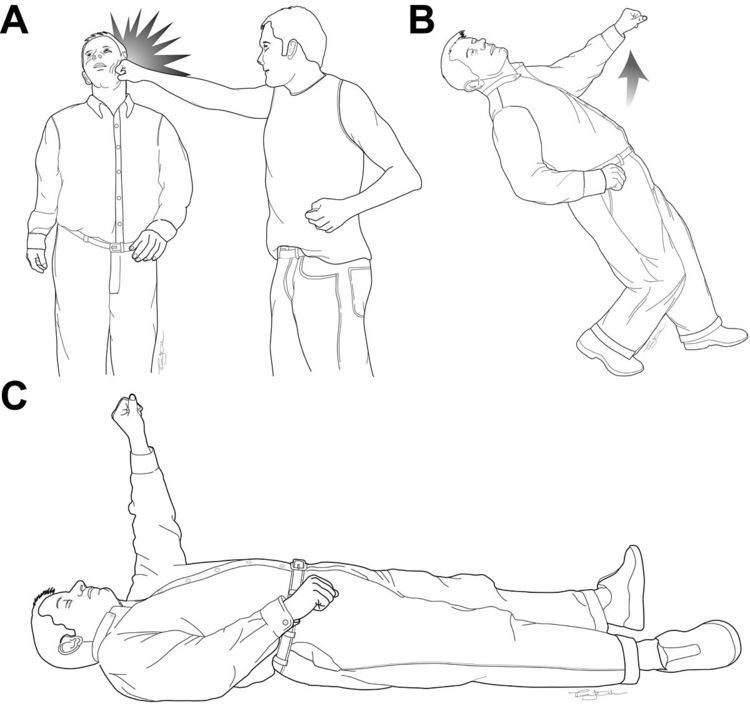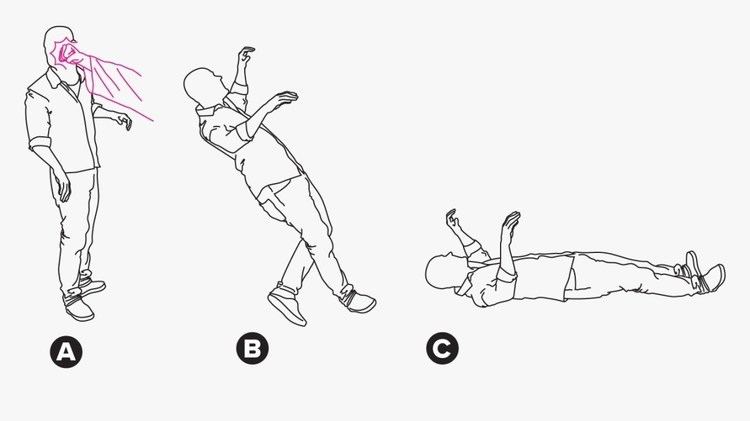 | ||
Similar Patellar dislocation, Saddle sore, Surfer's ear Position Unnatural | ||
The fencing response is a peculiar position of the arms following a concussion. Immediately after moderate forces have been applied to the brainstem, the forearms are held flexed or extended (typically into the air) for a period lasting up to several seconds after the impact. The fencing response is often observed during athletic competition involving contact, such as American football, hockey, rugby and martial arts. It is used as an overt indicator of injury force magnitude and midbrain localization to aid in injury identification and classification for events including, but not limited to, on-field and/or bystander observations of sports-related head injuries.
Contents
- Budda Baker Carted Off After Hit and Fencing Response Doctor Explains
- Relationship to fencing reflex and posturing
- Pathophysiology
- Injury severity and sports applications
- Further application
- Notable fencing displays
- References
Budda Baker Carted Off After Hit and Fencing Response - Doctor Explains
Relationship to fencing reflex and posturing
The fencing response designation arises from the similarity to the asymmetrical tonic neck reflex in infants. Like the reflex, a positive fencing response resembles the en garde position that initiates a fencing bout, with the extension of one arm and the flexion of the other.
Tonic posturing (see abnormal posturing) preceding convulsion has been observed in sports injuries at the moment of impact where extension and flexion of opposite arms occur despite body position or gravity. The fencing response emerges from the separation of tonic posturing from convulsion and refines the tonic posturing phase as an immediate forearm motor response to indicate injury force magnitude and location.
Pathophysiology

The neuromotor manifestation of the fencing response resembles reflexes initiated by vestibular stimuli. Vestibular stimuli activate primitive reflexes in human infants, such as the asymmetric tonic neck reflex, Moro reflex, and parachute reflexes, which are likely mediated by vestibular nuclei in the brainstem. The lateral vestibular nucleus (LVN; Deiter’s nucleus) has descending efferent fibers in the vestibulocochlear nerve distributed to the motor nuclei of the anterior column and exerts an excitatory influence on ipsilateral limb extensor motoneurons while suppressing flexor motoneurons. The anatomical location of the LVN, adjacent to the cerebellar peduncles (see cerebellum), suggests that mechanical forces to the head may stretch the cerebellar peduncles and activate the LVN. LVN activity would manifest as limb extensor activation and flexor inhibition, defined as a fencing response, while flexion of the contralateral limb is likely mediated by crossed inhibition necessary for pattern generation.
Injury severity and sports applications
In a survey of documented head injuries followed by unconsciousness, most of which involved sporting activities, two thirds of head impacts demonstrated a fencing response, indicating a high incidence of fencing in head injuries leading to unconsciousness, and those pertaining to athletic behavior. Likewise, animal models of diffuse brain injury have illustrated a fencing response upon injury at moderate but not mild levels of severity as well as a correlation between fencing, blood brain barrier disruption, and nuclear shrinkage within the LVN, all of which indicates diagnostic utility of the response. The most challenging aspect to managing sport-related concussion (mild traumatic brain injury, TBI) is recognizing the injury. Consensus conferences have worked toward objective criteria to identify mild TBI in the context of severe TBI. However, few tools are available for distinguishing mild TBI from moderate TBI. As a result, greater emphasis has regularly been placed on the management of concussions in athletes than on the immediate identification and treatment of such an injury. On-field predictors of injury severity can define return-to-play guidelines and urgency of care, but past criteria have either lacked sufficient incidence for effective utility, did not directly address the severity of the injury, or have become cumbersome and fraught with interrater reliability issues. By providing a clear, discernible physiological event immediately upon injury, the fencing response can discern moderate brain injury forces from milder forces, providing an additional criterion by which the identification and classification of concussions can be improved, with immediate application to sport-related on-field diagnoses and decisions affecting return-to-play status for athletes, thereby facilitating the transition from diagnosis to the treatment of any post-concussion symptoms (PCS).
Further application
The fencing response may also have the potential to indicate traumatic brain injury for soldiers in military settings, specifically with regard to blast injury and subsequent shell shock. There are currently no studies or data to determine the utility of the fencing response in such an arena.
Notable fencing displays
Increased awareness of clinical significance on behalf of the bystander is critical to the utility of the fencing response designation. Therefore, notable fencing displays are listed below in order to aid the bystander in identifying the various physical manifestations of the fencing response as well as demonstrating the prevalence of such a response in popular sporting and social events.
